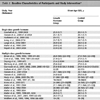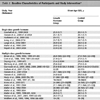- Home
- About Journals
-
Information for Authors/ReviewersEditorial Policies
Publication Fee
Publication Cycle - Process Flowchart
Online Manuscript Submission and Tracking System
Publishing Ethics and Rectitude
Authorship
Author Benefits
Reviewer Guidelines
Guest Editor Guidelines
Peer Review Workflow
Quick Track Option
Copyediting Services
Bentham Open Membership
Bentham Open Advisory Board
Archiving Policies
Fabricating and Stating False Information
Post Publication Discussions and Corrections
Editorial Management
Advertise With Us
Funding Agencies
Rate List
Kudos
General FAQs
Special Fee Waivers and Discounts
- Contact
- Help
- About Us
- Search

Open Biological Sciences Journal
(Discontinued)
ISSN: 2352-6335 ― Volume 4, 2018
Accumulation of Heavy Metals (Fe, Mn, Cu, Zn, Ni, Pb, Cd and Cr) in Tissues of Narrow-barred Spanish mackerel (Family-Scombridae) Fish Marketed by Karachi Fish Harbor
Quratulan Ahmed 1, *, Levent Bat 2, Farzana Yousuf 3, Qadeer Mohammad Ali 1, Kanwal Nazim 1
Abstract
In the present study, Scomberomorus commerson was collected during the period 2006-2011 in order to provide information on the concentrations of eight heavy metals present in this marine species commonly consumed by the population and to have knowledge whether these levels may constitute a hazard to consumers. Liver showed high concentrations of metals in the tissues and organs. Fe is the most accumulated in all tissues and organs. The highest mean concentration of Fe (608.93+113.22 µg/g), Mn (9.79+4.22 µg/g), Cu (38.57+16.62 µg/g), Zn (53.25+26.50 µg/g), Ni (3.22+1.13 µg/g), Pb (1.20+0.64 µg/g), Cd (2.03+0.91 µg/g) and Cr (1.93 + 0.87 µg/g) was determined in liver of fish. The order of abundance of the metals in the fish samples based on concentrations in the muscle tissues analysed were as follows: Fe>Zn>Cu>Mn>Ni>Cd>Pb≥Cr. For the toxic metal, Pb was found to have lower concentration of the mean values than the permissible limits set by FAO/WHO. However, Cd level was higher than the permissible limit and it can be concluded that the contamination of Cd in S. commerson may pose threat for the importers due to high per capita consumption of the fish.
Article Information
Identifiers and Pagination:
Year: 2015Volume: 1
First Page: 20
Last Page: 28
Publisher Id: BIOLSCI-1-20
DOI: 10.2174/2352633501501010020
Article History:
Received Date: 11/3/2015Revision Received Date: 22/4/2015
Acceptance Date: 22/5/2015
Electronic publication date: 17/9/2015
Collection year: 2015
open-access license: This is an open access article licensed under the terms of the Creative Commons Attribution Non-Commercial License (http://creativecommons.org/licenses/by-nc/3.0/) which permits unrestricted, non-commercial use, distribution and reproduction in any medium, provided the work is properly cited.
* Address correspondence to this author at the Marine Reference Collection and Resources Centre, University of Karachi, Karachi, 75270 Pakistan; Tel: +92-345-2983586; E-mail: quratulanahmed_ku@yahoo.com
| Open Peer Review Details | |||
|---|---|---|---|
| Manuscript submitted on 11-3-2015 |
Original Manuscript | Accumulation of Heavy Metals (Fe, Mn, Cu, Zn, Ni, Pb, Cd and Cr) in Tissues of Narrow-barred Spanish mackerel (Family-Scombridae) Fish Marketed by Karachi Fish Harbor | |
1. INTRODUCTION
The seas and oceans, which cover 70% of the world’s surface, are one of the man’s great hopes for future food supplies. As human populations multiply and industrialization increases, the problems of environmental pollution become more critical [1Williams J. Introduction to marine pollution control. USA: John Wiley-Inter Science Publication 1979; pp. 1-50.]. Beijer and Jernelov [2Beijer K, Jernelov A. Sources, transport and transformation of metals in the environment In: Friberg L, Nordberg GF, Vouk VB, Eds. Handbook on the toxicology of metals. Amsterdam: Elsevier 1986; pp. 68-84.] reported that heavy metals are critical in this regard because of their easy uptake into the food chain and bioaccumulation processes they are enter the marine environment naturally through weathering of the earth’s crust. In addition to geological weathering, human activities have also introduced large quantities of metals to local water bodies, thereby disturbing the natural balance in the ecosystem [3FA rstner U, Wittmann GT. Metal pollution in the aquatic environment Second. Revised ed.. Berlin: Springer-Verlag 1983.]. Industrial effluents, agricultural runoffs, transport, burning of fossil fuels, animal and human excretions and geologic weathering and domestic waste contribute to the heavy metals in the water bodies [4Adnano DC. Trace metals in the terrestrial environment. New York: Springer Verlag 1986.]. In harbors there is usually an increase in the pollution level including heavy metal, which will restrict the range of species including fish, but those organisms that are able to withstand the pollutants can abound.
Karachi is capital of Sindh as well as the largest and most populous metropolitan city of Pakistan and the main seaport and financial center of the country. The population of Karachi is 23.5 million people as of 2013 and area of approximately 3527 km2, resulting in a density of more than 6,000 people per square kilometer. Karachi is the location of the Port of Karachi and Port Bin Qasim, two of the region's largest and busiest ports. The city is with maximal population density and is located on the Arabian Sea coastline. The main drivers along the coast impacting on the marine environment are: industry, shipping, tourism, port activity, urbanization and agriculture. The main types of industry contributing to the amount of industrial waste waters are chemical industry, energy power stations, automotive industry, textiles, food industry, shipbuilding and ship repair. The waste waters from industrial complexes mainly discharge into the sea. The tourism is another major driver responsible for human impact on the marine water quality.
Fish constitute an important source of protein for many people throughout the world and fish consumption has increased in importance among health-conscious people because it provides healthy and low cholesterol sources of protein and other nutrients [5Burger J, Gochfeld M. Heavy metals in commercial fish in New Jersey Environ Res 2005; 99(3): 403-12.
[http://dx.doi.org/10.1016/j.envres.2005.02.001] [PMID: 16307983] , 6Agusa T, Kunito T, Yasunaga G, et al. Concentrations of trace elements in marine fish and its risk assessment in Malaysia Mar Pollut Bull 2005; 51(8-12): 896-911.
[http://dx.doi.org/10.1016/j.marpolbul.2005.06.007] [PMID: 16023148] ]. Heavy metals such as copper (Cu) and zinc (Zn) are essential for fish metabolism while some others such as lead (Pb) have no known role in biological systems. For the normal metabolism of fish, the essential metals must be taken up from water, food or sediment. However, similar to the route of essential metals, non-essential ones are also taken up by fish and accumulate in their tissues [7Canli M, Atli G. The relationships between heavy metal (Cd, Cr, Cu, Fe, Pb, Zn) levels and the size of six Mediterranean fish species Environ Pollut 2003; 121(1): 129-36.
[http://dx.doi.org/10.1016/S0269-7491(02)00194-X] [PMID: 12475070] -3FA rstner U, Wittmann GT. Metal pollution in the aquatic environment Second. Revised ed.. Berlin: Springer-Verlag 1983.]. Mansour and Sidky [14Mansour SA, Sidky MM. Ecotoxicological studies, 3. Heavy metals contaminating water and fish from Fayoum Governorate Egypt Food Chem 2002; 78: 15-22.
[http://dx.doi.org/10.1016/S0308-8146(01)00197-2] ] reported fish are often at the top of the food chain and have the tendency to concentrate heavy metals from water. Therefore, bioaccumulation of metals in fish can be considered as an index of metal pollution in aquatic ecosystems [3FA rstner U, Wittmann GT. Metal pollution in the aquatic environment Second. Revised ed.. Berlin: Springer-Verlag 1983., 15Jimoh LA, Adebayo MA, Amood IA. Evaluation of the body burdens of heavy metals in five commercially important fishes from different locations in Kainji Lake 19th Annual Conference of the Fisheries Society of Nigeria (FISON). 702-9., 16Karadede H, AonlA1/4 E. Concentrations of some heavy metals in water, sediment, fish and some benthic organisms from Tigris River, Turkey Environ Monit Assess 2007; 131: 323-37.
[http://dx.doi.org/10.1007/s10661-006-9478-0] [PMID: 17171266] ]. That could be a useful tool to study the biological role of metals present at higher concentration in fish [17Bat L, A-ztA1/4rk M, A-ztA1/4rk M. Heavy metal amounts in some commercial teleost fish from the Black Sea OMAo Fen Dergisi 1996; 7(1): 117-35., 18Dural M, GAksu MZ, A-zak AA. Investigation of heavy metal levels in economically important fish species captured from the Tuzla lagoon Food Chem 2007; 102: 415-21.
[http://dx.doi.org/10.1016/j.foodchem.2006.03.001] ].
The objective of this study was to determine the heavy metal concentration in muscles, liver, kidney, gills and gonads of Scomberomorus commerson collected from Karachi Fish Harbor. Moreover, the present study sought to establish the potential risk to humans due to consumption of contaminated fish with the heavy metals.
2. MATERIAL AND METHODS
Total of 294 fish samples were purchased from Karachi fish harbor during September 2006-December 2011. The lengths (cm) and weights (g) of fish samples obtained for analyses and years are summarized in Table 1. The fish samples were collected and transported to the laboratory in ice boxes and stored at -10oC until subjected for further analysis sample cleaned with sterile distilled water and then dissected. Fishes were dissected using steel scissors and scalpels to remove approximately 5 g dorsal muscles, entire liver, 2 rakers of gills, entire kidney and entire gonads were dissected, washed with deionized water and weighed fresh wt. (g). After taken fresh weight of samples were ground and calcinated at 500oC for 3 hours until it turned to white or grey ash. The ashes were dissolved with 10 millilitres of 0.1 M HCl according to the method of Gutierrez et al. [19Gutierrez M, Stablier RE, Arias AM. Accumulation y effectos histpatologicos del Cd yel Hg en el pez sapo (Halobatrachus didactylus) Investig Pesq 1978; 42: 141-54.] and after which the dissolved ash residue was filtered with Whatman filter paper. 1 ml filtered solution diluted with 25 ml distilled water and make standards for elemental analysis. The equipment (Analyst 700) was started and prepared programme win lab 32 software. Three standards from 1000 ppm stock solution to 2 ppm, 4 ppm and 6 ppm were prepared. The equipment with the above mentioned standards were calibrated. The samples one by one were aspirated to detect the required metals. Finally the report using the software was prepared. Descriptive statistics (mean, standard deviation, range) and three-way analysis of variance (ANOVA) were conducted using excel software. The data transformations allowed for adjusting of all the zero values in the analytical results prior to the ANOVA test. A three-way ANOVA statistical procedure was employed in the assessment of variation in metal concentrations among fish species. Three-way Analysis of variance (ANOVA) in which the within sample variances and between the sample variances were considered, was utilized to test for the significance of differences between organs and between metals [20Snedecor GW, Cochran WG. Statistical methods. New York: Oxford and IBH Publishing Co 1967; p. 593.].
3. RESULTS AND DISCUSSION
The commercially important fish S. commerson was marketed by local fishermen in the most important fishing municipalities in Karachi Fish Harbor, Pakistan to determine eight heavy metals in the tissues and organs of the fish. Concentrations of Fe, Mn, Cu, Zn, Ni, Pb, Cd and Cr in muscles, liver, kidney, gills and gonads of analyzed fish species, expressed by mean value ± standard deviation and range are presented in Table 2.
Liver showed high concentrations of metals in the tissues and organs of narrow-barred Spanish mackerel during all years of the present study. The highest mean concentration of Fe (608.93±113.22 µg/g), Mn (9.79±4.22 µg/g), Cu (38.57±16.62 µg/g), Zn (53.25±26.50 µg/g), Ni (3.22±1.13 µg/g), Pb (1.20±0.64 µg/g), Cd (2.03±0.91 µg/g) and Cr (1.93 + 0.87 µg/g) was determined in liver of fish. The distribution of these metals in the organs and tissues of S. commerson samples is highly non-homogeneous (Table 3). These results suggest that the mechanism of entry in to the body is mainly through digestive tract, which seems justified by the ingestion of food. There is general concern about the build-up of relatively high concentrations of metals in predators at the top of food chains. It is important to note that this fish species diet is based on small fishes like anchovies, clupeids, carangids, also squids and shrimps. The concentrations of the non-essential metals Cd and Pb were generally lower than those in other metals in the fish analysed. Both metals were found to largely accumulate in the liver. In the meantime, kidney like liver could also be the major reserve organ of any of the metals. Landis and Yu [21Landis WG, Yu MH. Introduction to environmental toxicology: impacts of chemicals upon ecological systems. Boca Raton, Florida: Lewis Publishers 1995; p. 328.] pointed out that liver plays a central role in metabolizing chemicals foreign to the body and is one of the most important metal storage organs by the digestive tract. It should be emphasised that exposure time is important determinant of toxic effects. The lowest mean concentrations of Cd (0.19±0.06) and Pb (0.14±0.12 µg/g) were recorded in the muscle tissues.
It is clear that the gills are also one of the major organ of accumulation of heavy metals, since they are in direct contact with the water and therefore are the first barrier of defence and because gills are the first organs to be exposed to suspended particles in the water column.
Fe is the most accumulated in all tissues and organs. The essential metals, particularly Mn, Zn and Cu were evenly distributed across the different fish tissues and organs (Table 2). Zn, Cu and Ni levels were higher in the muscles than those in other tissues except liver. The order of abundance of the metals in the fish samples based on concentrations in the muscle tissues analysed were as follows: Fe>Zn>Cu> Mn>Ni>Cd>Pb≥Cr. Recently, Bat [22Bat L. Heavy metal pollution in the Black Sea In: DA1/4zgA1/4ne Y E, A-ztA1/4rk B, Zengin M, Eds. Turkish Fisheries in the Black Sea Published by Turkish Marine Research Foundation (TUDAV), Publication number: 40, ISBN: 987-975-8825-32-5 Istanbul. Turkey 2014; pp. 71-107.] reviewed the results of the selected heavy metals (Fe, Zn, Ni, Cu, Mn, Pb, Cd and Co) in fish captured from the Black Sea coasts of Turkey and the metal concentrations decrease in the order Zn>Fe>Cu> Mn>Pb>Ni>Co>Cd. Below is a summary of the general distribution of the eight heavy metals in the tissues and organs:
Fe: Liver> Kidney>Muscles> Gills> Gonads
Mn: Liver> Kidney> Gills> Gonads>Muscles
Cu: Liver>Muscles>Gills >Kidney>Gonads
Zn: Liver>Muscles> Kidney> Gills> Gonads
Ni: Liver>Muscles>Kidney>Gonads>Gills
Pb: Liver>Gonads>Gills>Muscles>Kidney
Cd: Liver>Gills>Kidney>Gonads>Muscles
Cr: Liver>Gills>Muscles>Kidney>Gonads
In general, results of the present study show a trend similar to what many authors have pointed out before around the world, about the accumulation of these metals in fish tissues [7Canli M, Atli G. The relationships between heavy metal (Cd, Cr, Cu, Fe, Pb, Zn) levels and the size of six Mediterranean fish species Environ Pollut 2003; 121(1): 129-36.
[http://dx.doi.org/10.1016/S0269-7491(02)00194-X] [PMID: 12475070] , 10TA1/4zen M. Determination of heavy metals in fish samples of the middle Black Sea (Turkey) by graphite furnace atomic absorption spectrometry Food Chem 2003; 80: 119-23.
[http://dx.doi.org/10.1016/S0308-8146(02)00264-9] , 23Kalay M, Ay O, Canli M. Heavy metal concentrations in fish tissues from the Northeast Mediterranean Sea 1999.
[http://dx.doi.org/10.1007/s001289901033] -29Bat L, zahin F, AostA1/4n F, Sezgin M. Distribution of Zn, Cu, Pb and Cd in the tissues and organs of Psetta maxima from Sinop coasts of the Black Sea, Turkey Mark Sci 2012; 2(5): 105-9.
[http://dx.doi.org/10.5923/j.ms.20120205.10] ]. Also, authors agree that liver is the highest concentrations of heavy metals analysed are shown.
Legal thresholds are not available for essential elements in Europe. Commission Regulation (EC) [30] indicates that maximum level is 0.30 mg kg-1 wet weights for Pb. However, in the muscle tissues of fish the mean metal concentrations exceed the permissible limits of Pb established by Commission Regulation (EC) [30], but was still acceptable according to Georgian and Russian Federation limits for Pb (mg/kg wet weight) which is 1.0 [31Fish, other river/sea products and products made from them SanPiN-232560-96 The Minister's Decree 16/08/2001 N301/n for Health. Labor and Social Affairs 2001., 322002.]. Pb contents in the fish samples were within the permissible limits.
The Joint FAO/WHO Expert Committee on Food Additives established a PTWI for Pb of 0.025 mg/kg body weight/week which was equivalent to 1.725 mg/week for a 70 kg adult [33]. In Pakistan, where the average weekly consumption of fish is 35 g per person and the maximum Pb levels in muscle tissues of S. commerson, weekly intake calculated ranged from 0.005±0.004 mg (35 g x 0.14±0.12 mg/1000 g) in 2006-2007 to 0.019±0.013 mg (35 g x 0.54±0.37 mg/1000 g) in 2010-2011, which is less than the maximum permissible intake of Pb established by FAO/WHO [33]. Similarly, Tabinda etal. [34Tabinda AB, Hussain M, Ahmed I, Yasar A. Accumulation of toxic and essential trace metals in fish and prawns from Keti Bunder Thatta District, Sindh Pak J Zool 2010; 42(5): 631-8.] showed that Pb levels in Pampus argenteus and Tenualosa ilisha from Keti Bunder, south-east of Karachi in Thatta district of Sindh province, Pakistan exceeded the recommended limits.
In case of Cd, Commission Regulation (EC) [30] indicates that maximum level is 0.05 mg kg-1 wet weight. The permissible limits for Cd Moreover, the Joint FAO/WHO Expert Committee on Food Additives established a PTWI for Cd of 0.007 mg/kg body weight/week which was equivalent to 0.49 mg/week for a 70 kg adult [33]. By using the means of weekly fish consumption in Pakistan of 35 g per person and the maximum Cd levels in muscle tissues of S. commerson, weekly intake calculated ranged from 0.007±0.002 mg (35 g x 0.19±0.06 mg/1000 g) in 2006-2007 to 0.024±0.012 mg (35 g x 0.68±0.42 mg/1000 g) in 2010-2011. As regards Cd concentrations in the muscle tissues of S. commerson, the estimated PTWI in the present study is higher than permissible limits and seems not to be appropriate for human health. Here, the results are similar to those reported by Raza et al. [35Raza R, Sayeed SA, Siddiqi R, Naz S. Trace metal contents in selected marine fish species of northwest coastal area of Karachi, Pakistan J Chem Soc Pak 2003; 25(4): 313-6.]. They found that Cd was found maximum in Parastromateus niger from northwest coastal area of Karachi. It is possible that short-term exposure to this metal doesn’t cause immediate health threats to humans. It is also worth pointing out that metal contents were expressed as µg.g-1 dry weight in the present study.
Results of these previous studies and the present study confirm that heavy metal concentrations in marine organisms have increased in coast of Karachi (see Figs. 1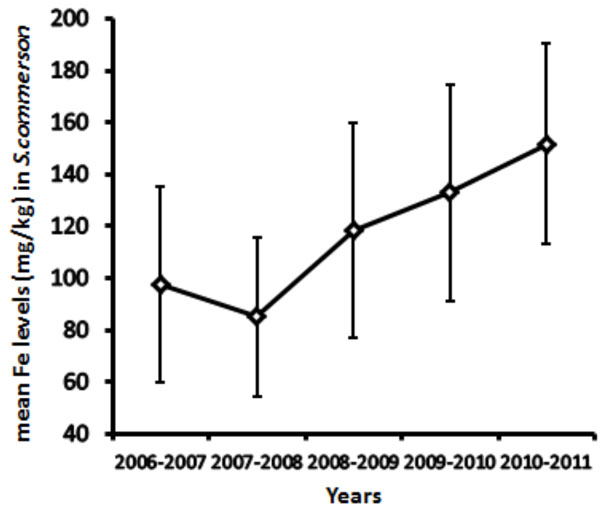 -8
-8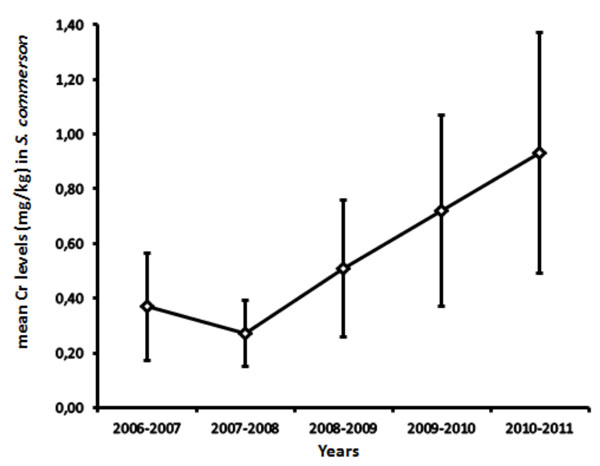 ). In the present study an approx. 1.7-1.8 fold increase of Ni and Zn levels in the fish samples in 2010-2011 compare with 2006-2007 (Figs. 4
). In the present study an approx. 1.7-1.8 fold increase of Ni and Zn levels in the fish samples in 2010-2011 compare with 2006-2007 (Figs. 4 -5
-5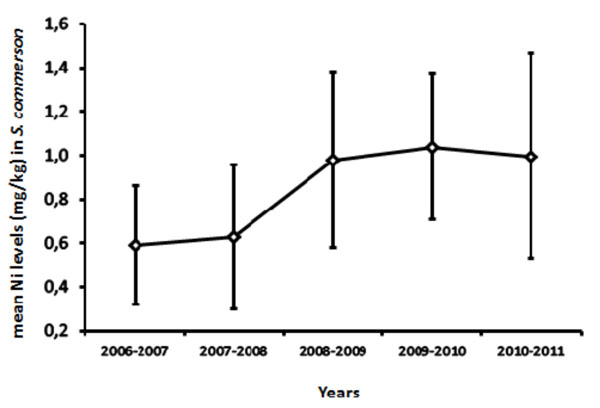 ). The results showed that Fe and Mn have increased 1.5 fold and Pb and Cr have increased 2.5 fold in 2010-2011 compare with 2006-2007 (Figs. 1
). The results showed that Fe and Mn have increased 1.5 fold and Pb and Cr have increased 2.5 fold in 2010-2011 compare with 2006-2007 (Figs. 1 , 2
, 2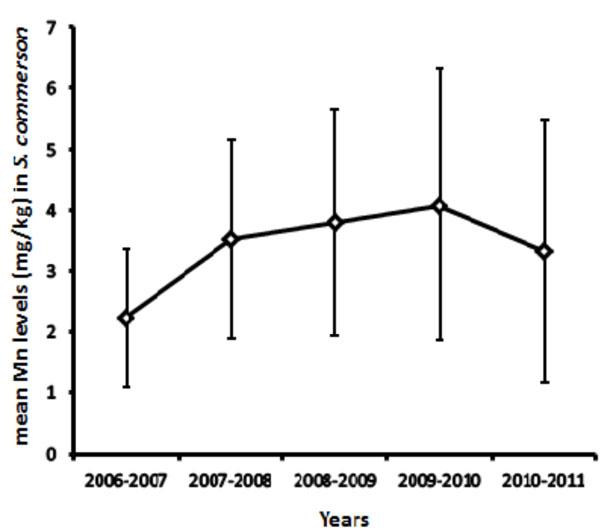 , 6
, 6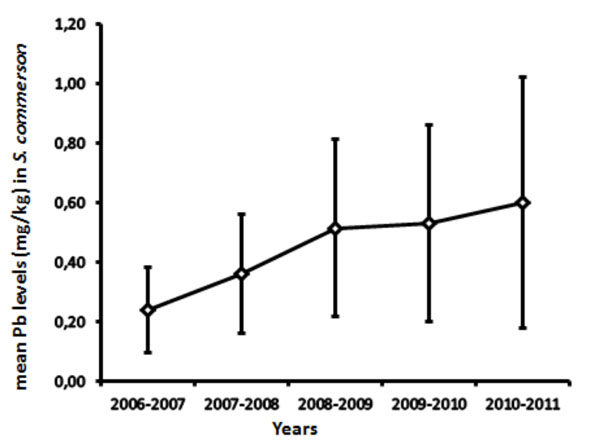 and 8
and 8 ). It was also observed that Cu and Cd have increased 1.44 fold and 3 fold, respectively during past five years (Figs. 3
). It was also observed that Cu and Cd have increased 1.44 fold and 3 fold, respectively during past five years (Figs. 3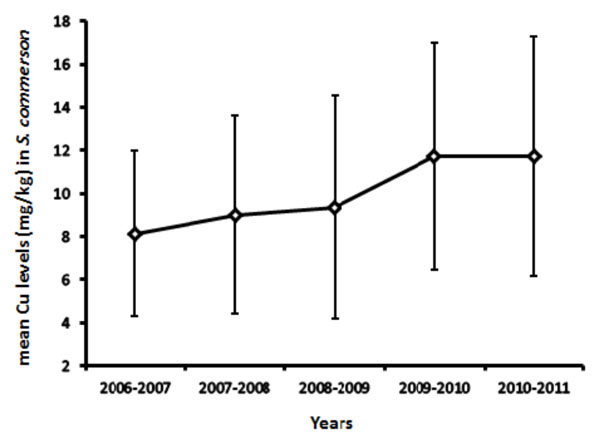 and 7
and 7 ). Heavy metal pollution of the Karachi coasts has become an important problem because of industrialization processes and pollutant loads from two main rivers discharging into the sea [35Raza R, Sayeed SA, Siddiqi R, Naz S. Trace metal contents in selected marine fish species of northwest coastal area of Karachi, Pakistan J Chem Soc Pak 2003; 25(4): 313-6.].
). Heavy metal pollution of the Karachi coasts has become an important problem because of industrialization processes and pollutant loads from two main rivers discharging into the sea [35Raza R, Sayeed SA, Siddiqi R, Naz S. Trace metal contents in selected marine fish species of northwest coastal area of Karachi, Pakistan J Chem Soc Pak 2003; 25(4): 313-6.].
 |
Fig. (1) Fe levels (mean± SD) in S. commerson from Karachi coast between 2006 and 2011. |
 |
Fig. (2) Mn levels (mean± SD) in S. commerson from Karachi coast between 2006 and 2011. |
 |
Fig. (3) Cu levels (mean± SD) in S. commerson from Karachi coast between 2006 and 2011. |
 |
Fig. (4) Zn levels (mean± SD) in S. commerson from Karachi coast between 2006 and 2011. |
 |
Fig. (5) Ni levels (mean± SD) in S. commerson from Karachi coast between 2006 and 2011. |
 |
Fig. (6) Pb levels (mean± SD) in S. commerson from Karachi coast between 2006 and 2011. |
 |
Fig. (7) Cd levels (mean± SD) in S. commerson from Karachi coast between 2006 and 2011. |
 |
Fig. (8) Cr levels (mean± SD) in S. commerson from Karachi coast between 2006 and 2011. |
CONCLUSION
The heavy metal concentrations except Cd in the commercially important fish do not present any danger to human health. However, in the presence of intense local pollution in the sea, the pollution of the commercial fish may well attain the limiting concentrations. Another relevant consideration is the proportion of fish in diets in different countries and regions. In the light of the available data and the anthropogenic activities in the natural levels and relative proportions of the metals in the marine environment, investigations of marine organisms, especially those of commercial importance, must be continued.
CONFLICT OF INTEREST
The authors confirm that this article content has no conflict of interest.
ACKNOWLEDGEMENTS
Declared none.
REFERENCES
| [1] | Williams J. Introduction to marine pollution control. USA: John Wiley-Inter Science Publication 1979; pp. 1-50. |
| [2] | Beijer K, Jernelov A. Sources, transport and transformation of metals in the environment In: Friberg L, Nordberg GF, Vouk VB, Eds. Handbook on the toxicology of metals. Amsterdam: Elsevier 1986; pp. 68-84. |
| [3] | FA rstner U, Wittmann GT. Metal pollution in the aquatic environment Second. Revised ed.. Berlin: Springer-Verlag 1983. |
| [4] | Adnano DC. Trace metals in the terrestrial environment. New York: Springer Verlag 1986. |
| [5] | Burger J, Gochfeld M. Heavy metals in commercial fish in New Jersey Environ Res 2005; 99(3): 403-12. [http://dx.doi.org/10.1016/j.envres.2005.02.001] [PMID: 16307983] |
| [6] | Agusa T, Kunito T, Yasunaga G, et al. Concentrations of trace elements in marine fish and its risk assessment in Malaysia Mar Pollut Bull 2005; 51(8-12): 896-911. [http://dx.doi.org/10.1016/j.marpolbul.2005.06.007] [PMID: 16023148] |
| [7] | Canli M, Atli G. The relationships between heavy metal (Cd, Cr, Cu, Fe, Pb, Zn) levels and the size of six Mediterranean fish species Environ Pollut 2003; 121(1): 129-36. [http://dx.doi.org/10.1016/S0269-7491(02)00194-X] [PMID: 12475070] |
| [8] | TA1/4rkmen A, TA1/4rkmen M, Tepe Y, Akyurt I. Heavy metals in three commercially valuable fish species from Iskenderun bay, northern east Mediterranean sea, Turkey Food Chem 2005; 91: 167-72. [http://dx.doi.org/10.1016/j.foodchem.2004.08.008] |
| [9] | TA1/4rkmen M, TA1/4rkmen A, Tepe Y. Metal contaminations in five fish species from Black, Marmara, Aegean and Mediterranean Seas, Turkey J Chil Chem Soc 2008; 53(1): 1435-9. [http://dx.doi.org/10.4067/S0717-97072008000100021] |
| [10] | TA1/4zen M. Determination of heavy metals in fish samples of the middle Black Sea (Turkey) by graphite furnace atomic absorption spectrometry Food Chem 2003; 80: 119-23. [http://dx.doi.org/10.1016/S0308-8146(02)00264-9] |
| [11] | TA1/4zen M. Toxic and essential trace elemental contents in fish species from the Black Sea, Turkey Food Chem Toxicol 2009; 47(8): 1785-90. [http://dx.doi.org/10.1016/j.fct.2009.04.029] [PMID: 19406195] |
| [12] | Bat L, Sezgin M, AostA1/4n F, zahin F. Heavy metal concentrations in ten species of fishes caught in Sinop coastal waters of the Black Sea, Turkey Turk J Fish Aquat Sci 2012; 12: 371-6. [http://dx.doi.org/10.4194/1303-2712-v12_2_24] |
| [13] | Bat L, Sezgin M, GAkkurt Baki O, AostA1/4n F, zahin F. Determination of heavy metals in some commercial fish from the Black Sea coast of Turkey Walailak J Sci Tech 2013; 10(6): 581-9. |
| [14] | Mansour SA, Sidky MM. Ecotoxicological studies, 3. Heavy metals contaminating water and fish from Fayoum Governorate Egypt Food Chem 2002; 78: 15-22. [http://dx.doi.org/10.1016/S0308-8146(01)00197-2] |
| [15] | Jimoh LA, Adebayo MA, Amood IA. Evaluation of the body burdens of heavy metals in five commercially important fishes from different locations in Kainji Lake 19th Annual Conference of the Fisheries Society of Nigeria (FISON). 702-9. |
| [16] | Karadede H, AonlA1/4 E. Concentrations of some heavy metals in water, sediment, fish and some benthic organisms from Tigris River, Turkey Environ Monit Assess 2007; 131: 323-37. [http://dx.doi.org/10.1007/s10661-006-9478-0] [PMID: 17171266] |
| [17] | Bat L, A-ztA1/4rk M, A-ztA1/4rk M. Heavy metal amounts in some commercial teleost fish from the Black Sea OMAo Fen Dergisi 1996; 7(1): 117-35. |
| [18] | Dural M, GAksu MZ, A-zak AA. Investigation of heavy metal levels in economically important fish species captured from the Tuzla lagoon Food Chem 2007; 102: 415-21. [http://dx.doi.org/10.1016/j.foodchem.2006.03.001] |
| [19] | Gutierrez M, Stablier RE, Arias AM. Accumulation y effectos histpatologicos del Cd yel Hg en el pez sapo (Halobatrachus didactylus) Investig Pesq 1978; 42: 141-54. |
| [20] | Snedecor GW, Cochran WG. Statistical methods. New York: Oxford and IBH Publishing Co 1967; p. 593. |
| [21] | Landis WG, Yu MH. Introduction to environmental toxicology: impacts of chemicals upon ecological systems. Boca Raton, Florida: Lewis Publishers 1995; p. 328. |
| [22] | Bat L. Heavy metal pollution in the Black Sea In: DA1/4zgA1/4ne Y E, A-ztA1/4rk B, Zengin M, Eds. Turkish Fisheries in the Black Sea Published by Turkish Marine Research Foundation (TUDAV), Publication number: 40, ISBN: 987-975-8825-32-5 Istanbul. Turkey 2014; pp. 71-107. |
| [23] | Kalay M, Ay O, Canli M. Heavy metal concentrations in fish tissues from the Northeast Mediterranean Sea 1999. [http://dx.doi.org/10.1007/s001289901033] |
| [24] | Kwon TT, Lee CW. Ecological risk assessment of sediment in wastewater discharging area by means of metal speciation Microchem J 2001; 70: 255-64. [http://dx.doi.org/10.1016/S0026-265X(01)00122-9] |
| [25] | Cohen T, Hee SS, Ambrose RF. Trace metals in fish and invertebrates of three California coastal Wetlands Mar Pollut Bull 2001; 42(3): 224-32. [http://dx.doi.org/10.1016/S0025-326X(00)00146-6] [PMID: 11381877] |
| [26] | Topcuo Ylu S, Kirba Yo Ylu C, GA1/4ngAr N. Heavy metals in organisms and sediments from Turkish Coast of the Black Sea, 1997-1998 Environ Int 2002; 27(7): 521-6. [http://dx.doi.org/10.1016/S0160-4120(01)00099-X] [PMID: 11868661] |
| [27] | Bustamante P, Bocher P, ChA(c)rel Y, Miramand P, Caurant F. Distribution of trace elements in the tissues of benthic and pelagic fish from the Kerguelen Islands Sci Total Environ 2003; 313(1-3): 25-39. [http://dx.doi.org/10.1016/S0048-9697(03)00265-1] [PMID: 12922058] |
| [28] | Yilmaz AB. Levels of heavy metals (Fe, Cu, Ni, Cr, Pb, and Zn) in tissue of Mugil cephalus and Trachurus mediterraneus from Iskenderun Bay, Turkey Environ Res 2003; 92(3): 277-81. [http://dx.doi.org/10.1016/S0013-9351(02)00082-8] [PMID: 12804525] |
| [29] | Bat L, zahin F, AostA1/4n F, Sezgin M. Distribution of Zn, Cu, Pb and Cd in the tissues and organs of Psetta maxima from Sinop coasts of the Black Sea, Turkey Mark Sci 2012; 2(5): 105-9. [http://dx.doi.org/10.5923/j.ms.20120205.10] |
| [30] | |
| [31] | Fish, other river/sea products and products made from them SanPiN-232560-96 The Minister's Decree 16/08/2001 N301/n for Health. Labor and Social Affairs 2001. |
| [32] | 2002. |
| [33] | |
| [34] | Tabinda AB, Hussain M, Ahmed I, Yasar A. Accumulation of toxic and essential trace metals in fish and prawns from Keti Bunder Thatta District, Sindh Pak J Zool 2010; 42(5): 631-8. |
| [35] | Raza R, Sayeed SA, Siddiqi R, Naz S. Trace metal contents in selected marine fish species of northwest coastal area of Karachi, Pakistan J Chem Soc Pak 2003; 25(4): 313-6. |



